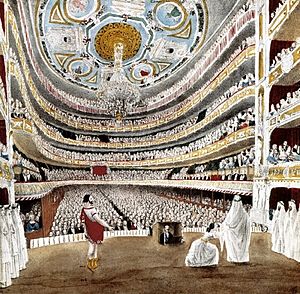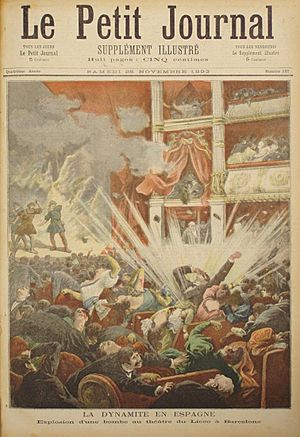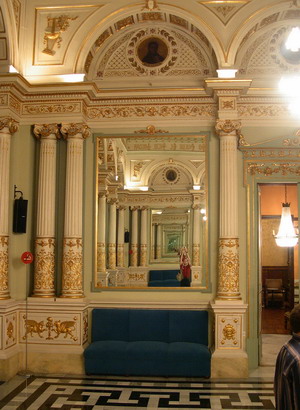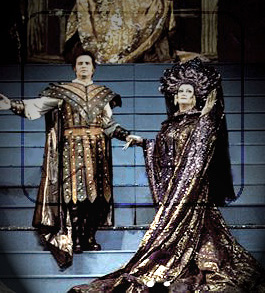Liceu facts for kids
|
Teatro del Liceo de Montesión (1837–1847)
|
|

Liceu façade towards La Rambla
|
|
| Address | La Rambla, 51–59 Barcelona, Catalonia, Spain |
|---|---|
| Coordinates | 41°22′49″N 2°10′25″E / 41.38028°N 2.17361°E |
| Public transit | Liceu |
| Owner | Fundació del Gran Teatre del Liceu |
| Type | Theater |
| Genre(s) | Opera |
| Capacity | 2,292 seats |
| Construction | |
| Opened | 4 April 1847 (founded 1837 at another location) |
| Reopened |
|
| Architect |
|
The Gran Teatre del Liceu, often just called Liceu, is a famous theater in Barcelona, Spain. It is located on La Rambla, a busy street in the city. The Liceu is the oldest theater building in Barcelona that is still used for its original purpose: putting on amazing shows!
The Liceu first started in 1837 in a different spot. It opened at its current location on April 4, 1847. The theater has been rebuilt twice after big fires, once in 1861 and again in 1994. It reopened on April 20, 1862, and then on October 7, 1999. In 1893, during an opening night, a bomb was thrown into the audience. About twenty people died, and many more were hurt.
Between 1847 and 1989, the Liceu was the largest opera house in Europe. It had 2,338 seats. Since 1994, a public group called the Fundació del Gran Teatre del Liceu has owned and managed the theater. The Liceu has its own choir, a symphony orchestra, and even a music school.
Contents
History of the Liceu
How the Liceu Began (1837–1847)
In 1837, a group called the Liceo Filodramático de Montesión was formed in Barcelona. Their goal was to teach music. This is why it was called "Liceo," which means "lyceum" or a place for learning. Students from this group would perform operas.
A theater was built in an old convent building, and plays and operas were performed there. The very first performance was an opera called Norma on February 3, 1838. Most of the operas performed were Italian, by composers like Donizetti and Rossini.
In 1838, the group changed its name. But they soon needed more space and had to leave the convent. The last show there was on September 8, 1844.
The managers of the Liceu bought a new building on La Rambla. They created two groups of shareholders to help pay for the new theater. People who bought shares got special rights to use certain theater boxes and seats forever.
Unlike many other European opera houses that were built by kings or queens, the Liceu was funded by private citizens. This is why the building doesn't have a special "royal box" for a monarch. Construction began on April 11, 1845, with Miquel Garriga i Roca as the architect. The new theater opened on April 4, 1847.
Opening, Fire, and Rebuilding (1847–1862)
The opening night featured a mix of performances, including a musical piece, a play, a ballet, and a song. The first full opera, Donizetti's Anna Bolena, was performed on April 17, 1847.
The Liceu was huge, with 3,500 seats, making it the biggest opera house in Europe at the time. Many famous operas by composers like Verdi and Bellini were performed in its first year.
Sadly, a fire badly damaged the building on April 9, 1861. But it was quickly rebuilt by architect Josep Oriol Mestres. It reopened on April 20, 1862, with Bellini's I puritani. Only the front of the building, the entrance hall, and the Hall of Mirrors survived the fire.
Bombing and Civil War (1862–1940)
On November 7, 1893, during the opening night of the season, two bombs were thrown into the theater. Only one exploded, but it killed about twenty people and injured many more. This attack by an anarchist named Santiago Salvador shocked Barcelona. The Liceu reopened on January 18, 1894, but the seats where people died were left empty for years.
In 1909, the main hall was updated. The 1920s were a good time for the Liceu. It welcomed famous singers, conductors, and groups like Sergei Diaghilev's Ballets Russes.
When the Second Spanish Republic was declared in 1931, the Liceu faced money problems. The city and regional governments helped it out. During the Spanish Civil War, the theater was taken over by the government and renamed. Opera seasons were stopped. After the war ended in 1939, the Liceu was given back to its original owners.
New Management and Second Fire (1980–1994)
By 1980, it was clear that the Liceu needed help from official groups to stay a top opera house. In 1981, the government of Catalonia, Barcelona's City Council, and the Liceu's owners created a group to manage the theater.
More government groups joined in 1985 and 1986. This new management quickly brought the public back by improving the quality of the shows. They focused on better singing, orchestra, and overall performances.
The theater kept its high standards until January 31, 1994, when another fire destroyed the building. A spark fell on the curtain during a repair. The next opera planned was Turandot.
Everyone agreed that the opera house needed to be rebuilt in the same spot, but with better facilities. The new Liceu kept parts of the old building that survived both fires. The main hall was rebuilt to look the same, but with new roof paintings and modern stage technology.
To rebuild and improve the theater, it became a public property. The Fundació del Gran Teatre del Liceu was created. Some people disagreed with this decision, but it went ahead.
Reopening and Modern Era (1994–present)
From 1994 until the Liceu reopened in 1999, Barcelona's opera shows were held in other venues. The rebuilt and improved theater opened on October 7, 1999, with Puccini's Turandot. This was the opera that was supposed to be performed when the 1994 fire happened. The new theater kept its traditional horseshoe shape but added modern technical, rehearsal, and office spaces.
Today, all opera performances have Surtitles (translations projected above the stage). Many seats also have small screens with translations in English, Spanish, or Catalan.
In 2020, during the COVID-19 pandemic, the Liceu held a special concert for an audience of 2,292 house plants. This performance was streamed online. Afterward, each plant was given to healthcare workers in Barcelona.
The Opera House Building
The theater is located on La Rambla in downtown Barcelona. It has two main fronts, as the other sides were surrounded by other buildings until 1994.
Some parts of the original building still remain:
- The main front on La Rambla (from 1847).
- The entrance hall and staircase (from 1861), which includes a statue of Music.
- The beautiful Hall of Mirrors (from 1847), decorated with paintings of famous musicians and dancers.
The main hall was rebuilt after the 1994 fire to look like the 1861 version, but with improvements. It can seat 2,292 people, making it one of Europe's largest opera houses. It has a typical Italian horseshoe shape with a main floor and five balconies. There are no columns in the main hall, so the balconies look like a golden horseshoe without anything blocking the view.
The decorations in the main hall are like those from 1909, with fancy gold and colorful plaster designs. Modern features were added during the rebuilding. The paintings on the roof and above the stage, which were lost in the fire, were recreated by artist Perejaume. The stage curtain was designed by Antoni Miró. A new lamp in the center of the roof holds technical equipment for lights and sound.
The stage is very modern, allowing for quick scene changes and the use of four different sets at once. A new area was built under the main hall for a bar, restaurant, and smaller performances. The Liceu station of the Barcelona Metro line 3 is right next to the theater.
Artistic History
Works Performed
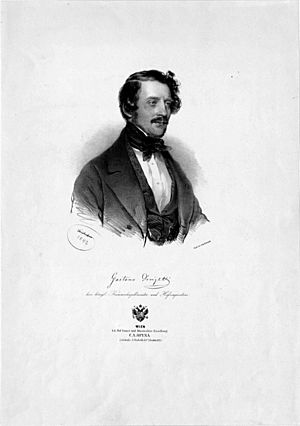
The Liceu both creates new shows and hosts performances from other opera houses. It has its own orchestra, choir, and singers for smaller roles. The main singers are usually guest performers. Most of the operas performed are from the 19th century, especially by Italian and German composers like Verdi and Wagner.
In the beginning, opera was just one part of the Liceu's activities. They also had Spanish light operas (called zarzuela), ballets, plays, and even magic shows. The first operas performed were by composers like Rossini, Donizetti, and Bellini. Verdi is still the most-performed composer at the Liceu.
The first operas by non-Italian composers were performed in Italian, which was common at the time. In 1883, Wagner's Lohengrin was first performed. From the 1880s to the 1950s, Wagner was one of the most popular composers at the Liceu.
In the early 1900s, famous composers like Richard Strauss and Pietro Mascagni conducted their own works at the Liceu. The theater also became known for Russian and German operas, which were then sung in their original languages. Famous ballet dancers like Anna Pavlova also performed here.
Since the 1950s, the Liceu has performed many of the world's most popular operas. It has also included works by important 20th-century composers like Bartók, Gershwin, and Britten. Ballet continues to be a key part of the theater's shows, with performances by top companies.
Most Popular Operas
Some of the operas performed most often at the Liceu include:
- Verdi's Aida
- Verdi's Rigoletto
- Gounod's Faust
- Donizetti's Lucia di Lammermoor
- Donizetti's La favorita
- Verdi's Il trovatore
- Wagner's Lohengrin
- Puccini's La bohème
- Rossini's Il barbiere di Siviglia
- Verdi's La traviata
- Bizet's Carmen
Stage Design
The Liceu developed its own style of stage design, known for realistic painted backdrops and curtains. These sets and costumes were made in the theater's own workshops. Famous scenery painters worked here from the 1900s to the 1950s.
Singers
Many famous singers have performed at the Liceu. When composer Camille Saint-Saëns visited, he joked that the Liceu audience "loved tenors too much."
Some of the notable singers who have graced the Liceu stage include:
- In the 1800s: Francesco Tamagno, Julián Gayarre, Francesc Viñas, and Maria Barrientos.
- In the early 1900s: Enrico Caruso (who only performed twice at the Liceu), Conchita Supervía, Hipólito Lázaro, and Miguel Fleta.
- From the 1940s to 1960s: Victoria de los Ángeles, Giuseppe Di Stefano, Kirsten Flagstad, Renata Tebaldi, Montserrat Caballé, Plácido Domingo, and Alfredo Kraus.
- More recently: José Carreras, Joan Pons, Edita Gruberová, Juan Diego Flórez, and Rolando Villazón.
The Liceu Team
The Liceu has a theater manager and an artistic director who guide its performances.
Orchestra and Conductors
The Liceu has had its own orchestra, the Orquestra Simfònica del Gran Teatre del Liceu, since it opened in 1847. It is Spain's oldest working orchestra. Its first conductor was Marià Obiols.
The current music director is Josep Pons, who will become honorary music director in 2026. Jonathan Nott will take over as the new music director in the 2026-2027 season.
Choir Conductors
The Liceu's choir has been led by several talented conductors over the years. The current choir conductor is William Spaulding.
Conservatori de Música del Liceu
The Conservatori Superior de Música del Liceu is a music school that started in 1837 and is connected to the theater.
Círculo del Liceo
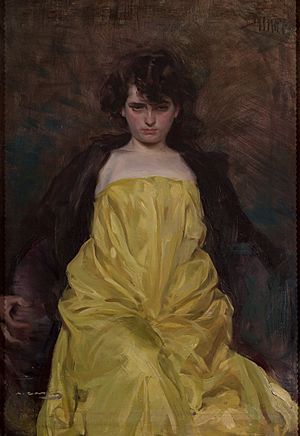
The Círculo del Liceo is a private club located inside the Liceu building. It opened in 1847 and has lounges, meeting rooms, a restaurant, and a library.
For its first 150 years, only men could be members. Women were only allowed as guests. In 2001, after some discussion, the club changed its rules to allow women to join. The club has about one thousand members today.
The Círculo del Liceo is the oldest club in Spain that is still in its original location. It has a large collection of art, and many of its rooms are decorated in the Art Nouveau style. The club's most famous artworks are twelve oil paintings by Ramon Casas, each inspired by music.
The Liceu in Stories and Movies
Literature
The Liceu has appeared in many books:
- Frederic Soler's comedy "Liceístas" i "cruzados" (1865), about the rivalry between fans of the Liceu and another Barcelona theater.
- Narcís Oller's novel, La febre d'or (1892).
- Ignacio Agustí's novels Mariona Rebull (1944) and El viudo Rius (1945), which talk about the 1893 bombing.
- Eduardo Mendoza's novel La ciudad de los prodigios (1986).
Films
The Liceu has also been featured in movies:
- Mariona Rebull (1947).
- Gayarre (1958), a movie about the singer Julián Gayarre.
- Circus World (1964), starring John Wayne, filmed some circus scenes inside the theater.
- Romanza final (1986), another film about Julián Gayarre's life.
- La febre d'or (1993), which includes parts of an opera performance.
- The Life of David Gale (2003), starring Kevin Spacey and Kate Winslet.
See also
 In Spanish: Gran Teatro del Liceo para niños
In Spanish: Gran Teatro del Liceo para niños
- Conservatori Superior de Música del Liceu
- List of theaters and concert halls in Barcelona
- Orquestra Simfònica del Gran Teatre del Liceu


